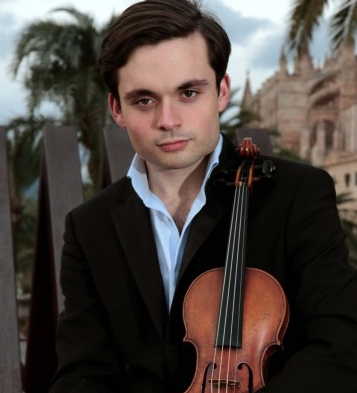Pro Musicis presents Francisco Fullana in Review
Pro Musicis presents Francisco Fullana
Francisco Fullana, violin
David Fung, piano; guest artist JP Jofre, bandoneón
Weill Recital Hall at Carnegie Hall, New York, NY
November 1, 2016
Pro Musicis continued its mission statement “Awaken the human spirit” in fine form last night with the recital of its 2015 award winner, Spanish violinist Francisco Fullana. The program was beautifully conceived, stunningly well-played, and thoughtful connections were drawn between the pieces on each half.
Mr. Fullana has a cherubic face, and he doesn’t scowl or contort it the way so many violinists do. In fact, the predominant emotion he conveyed (though not the only one) was the joy and playfulness in collaboration. He was actively listening to everything around him in his two musical partners. His pianist, David Fung, was superb. Mr. Fullana provided a real novelty in the presence of his frequent collaborator, young Argentine composer JP Jofre, who played the Argentine equivalent of the accordion, the bandoneón.
The program opened with a radiant interpretation of Bach’s Sonata for Violin and Keyboard in E major, BWV 1016. Mr. Fullana’s tone was appropriately scaled down (but never sterile), and he and Mr. Fung did not allow one single opportunity for dialog between the parts to go unexplored or unshaped. The technique and style were impeccable. In the final movement (which is preceded by a sorrowful cantilena), the sense of playfulness and joy of both players was vivid.
The contrast provided by the next piece could not have been more stark. Königliches Thema (1976) for unaccompanied violin, by the Korean composer Isang Yun (also spelled Yun I-sang), was the matter at hand. Yun (1917-1995) had an unimaginably tragic life, which included imprisonments, kidnapping, and torture at the hands of the Japanese and his fellow Koreans. Somehow, amid all this, he managed to study music in western Europe, and to keep his spirit from being broken through his composing. His music was even banned in South Korea until 1994, the year before his death.
The work is based on the famous origin melody for Bach’s next-to-last work, Das Musikalische Opfer. We now know with 99 percent certainty that it was in fact not Frederick the Great who provided the theme, but C.P.E. Bach, Bach’s son (and Frederick’s employee), who understood better than anyone his father’s ability to mine the potential lurking in any theme. Here Mr. Fullana’s tone suddenly became rich and darkened with tragedy, as each variation became more unhinged than the one before it. The technical demands of the work are severe, yet one never worried about his ability to surmount them. The piece ended on three fateful “knocks,” pizzicati perfectly graded so that they disappeared.
Then Mr. Fullana was joined on stage by Mr. Jofre, who partnered him in two of his own works for violin and bandoneón: Como el Agua (“Like water,” based on a Zen-like quote by Bruce Lee), and Tangódromo. It was wonderful to witness these two instruments and their players blending so totally into each other that at times one could not tell which one was playing which notes. Also notable was the extreme subtlety of which the bandoneón is capable, especially in the hands of Mr. Jofre (unlike the typical rush-hour serenading disrupters one encounters in the subways!). The water piece was mournful, and the tango-inspired one had great energy and wit.
After intermission, Mr. Fullana and Mr. Fung resumed their collaboration with one of Mozart’s most experimental sonatas in what was still a relatively new genre: the piano and violin sonata, with his Sonata, K. 303 (293c) in C major. Mozart stealthily gives the impression of two movements for the price of one, with the opening Adagio followed by an Allegro molto, until one realizes that those tempi changes are but the different parts of one sonata-form movement. There follows the true second movement, a Tempo di Menuetto, courtly dances often being considered the only polite way to end a “scholarly” piece like a sonata. In this work, both players recapped the almost supernatural unity they had found in the Bach, with perfect matching of articulation and phrase shape. It was perfection, and I don’t use that word lightly. Too often players either minimize or trivialize these gems.
Then came the sprawling Sonata for Violin and Piano by Richard Strauss (E-flat major, Op. 18), a composer not always thought of for his chamber music. The magic of collaboration continued with superb sensitivity to every harmonic shift (they occur about every two seconds in this work), and great virtuosity from both players. Mr. Fullana’s Stradivarius really got its “lungs expanded” in the big dimensions required by the piece, and Fung never overbalanced, amid the monster piano part. The aggressive moments were handled well, but in the soaring songlike melodies the transfiguration was even better.
After a large ovation, Mr. Fullana and Mr. Fung played two of De Falla’s violin arrangements (from songs): Nana (a lullaby) and El Paño moruno (the Moorish cloth, a metaphor for virginity!) with yearning authenticity.
Bravo to Pro Musicis for its track record, and to these three artists for elevating a room full of listeners seeking beauty.

